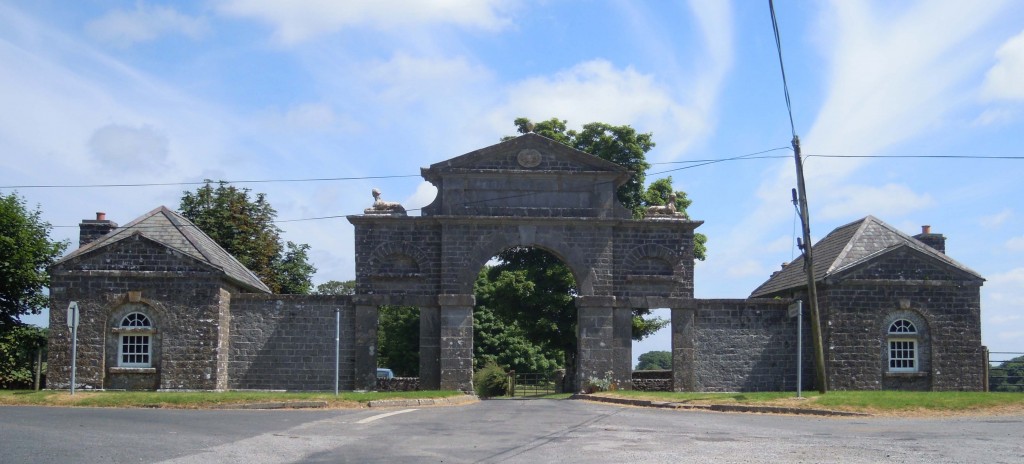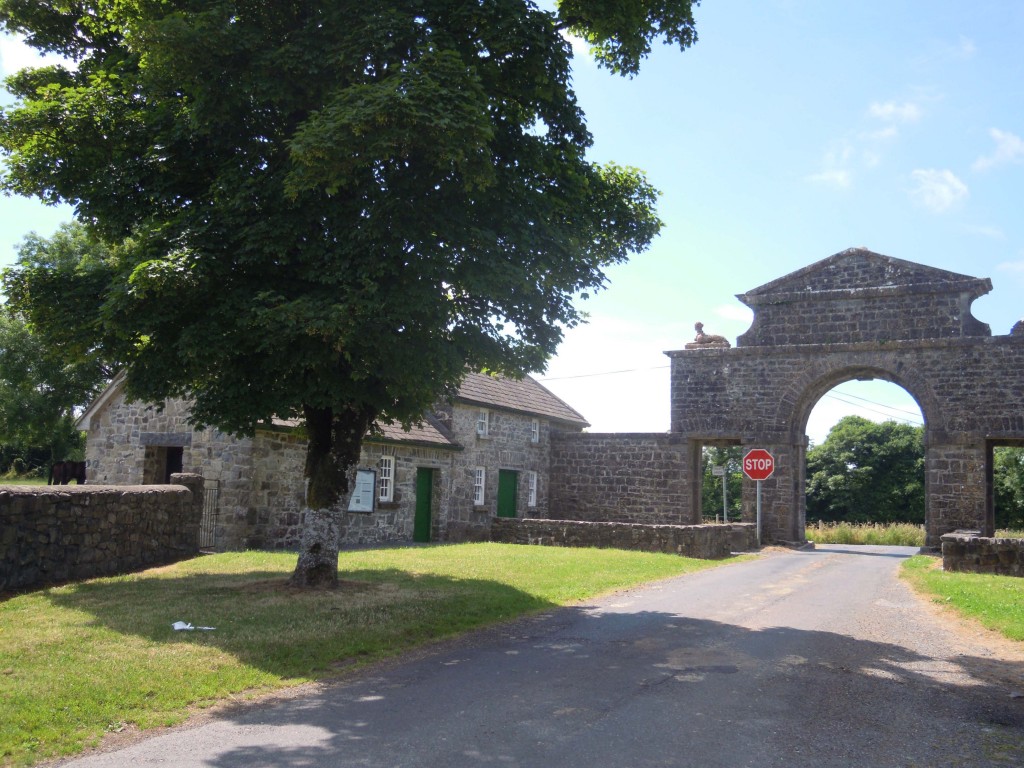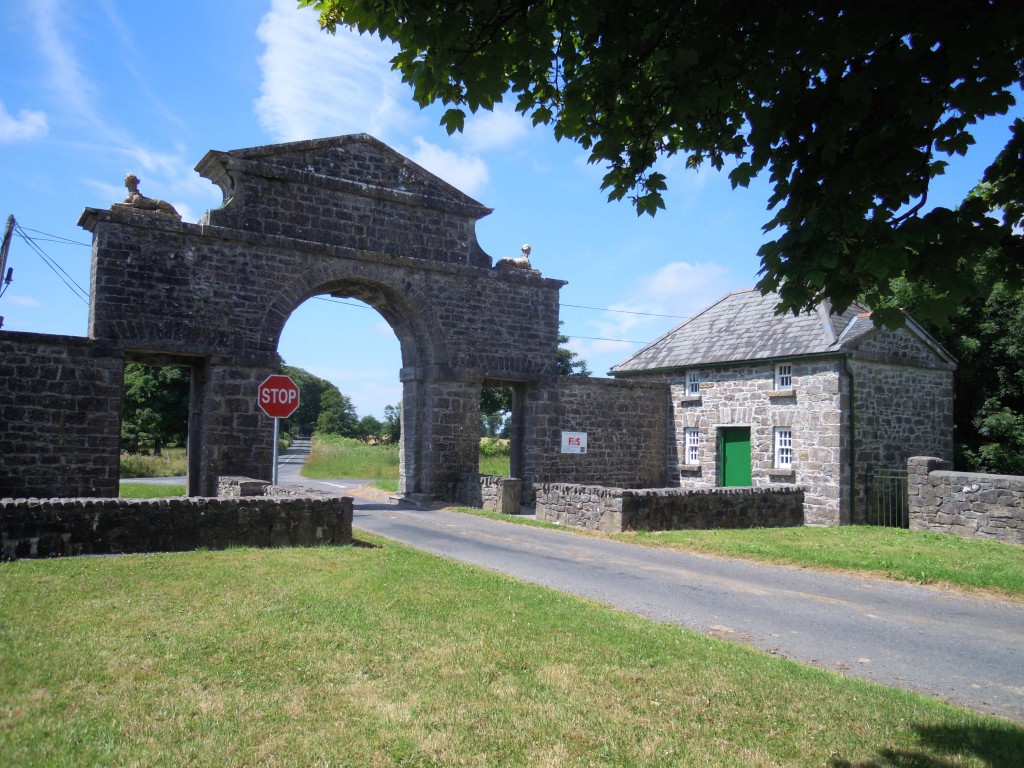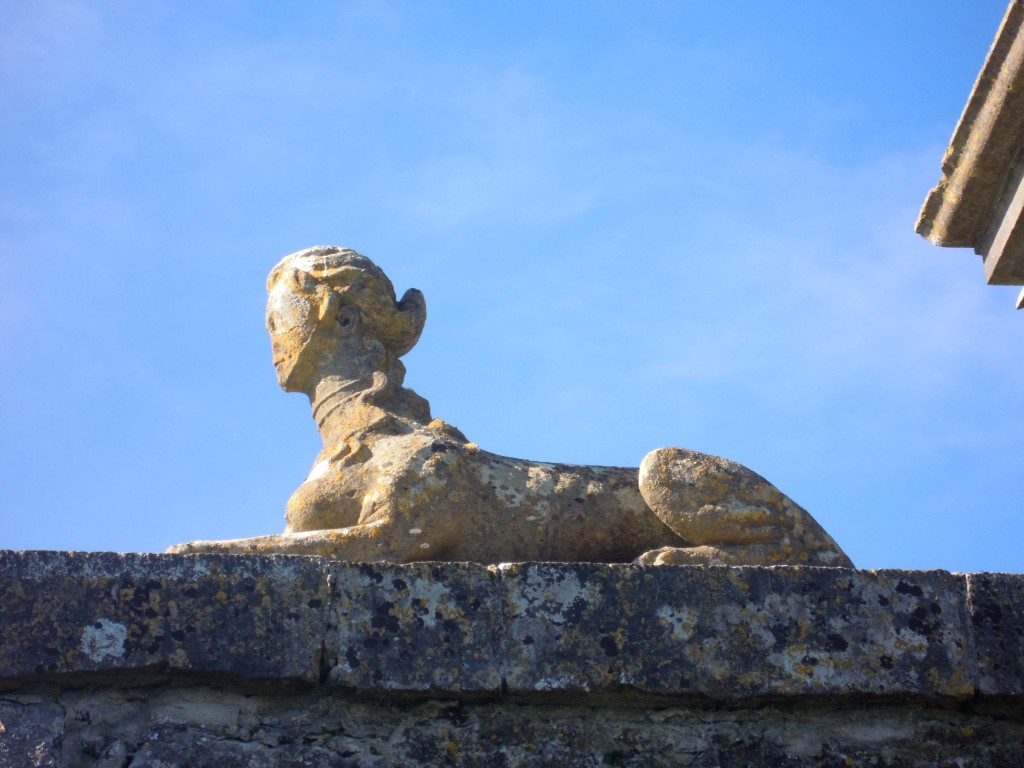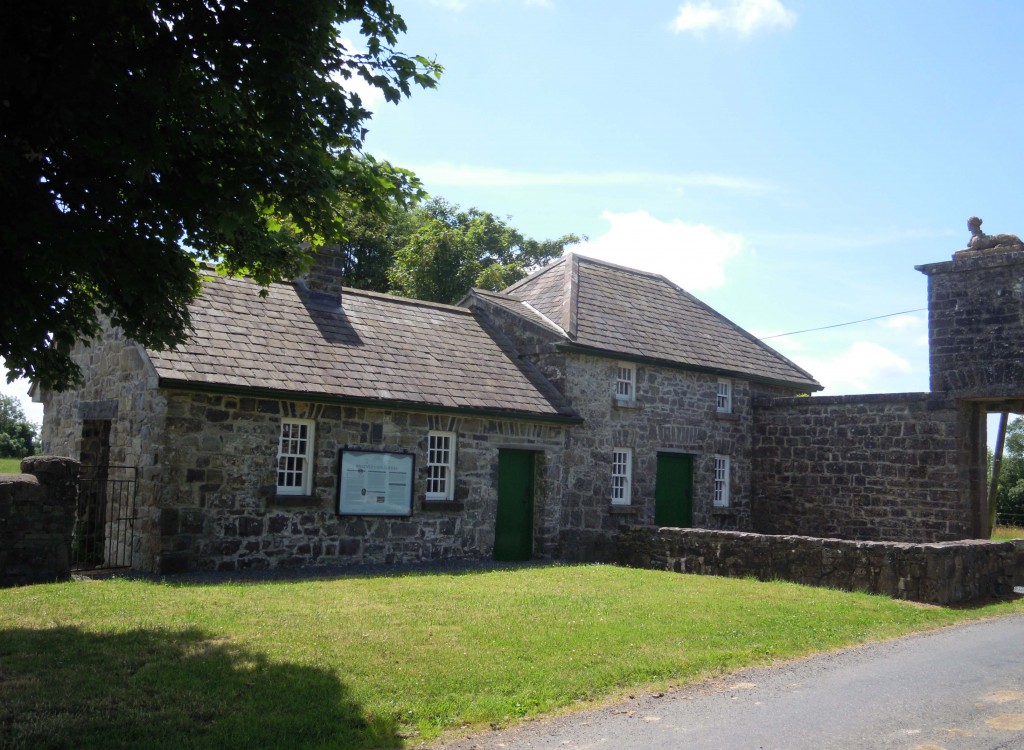© Donal G. Burke 2013
Colonel Walter Lawrence erected a classically-designed monumental gateway at the western entrance to his estate at Lisreaghan (modern townland of ‘Belview or Lissareaghaun’), near the village of Lawrencetown in east Galway in the late eighteenth century.
The gateway combined in its design a small pavilion-like gate-lodge on either side of its central arch and served as both a social and political statement. It simultaneously announced the taste and refinement of the patron while commemorating the contribution of the Irish Volunteers (with whom Lawrence was associated) to the attainment of legislative and economic freedom for Ireland. The Lawrence family appear to have referred to the gateway as ‘the Volunteer’s Gate’ or ‘Volunteer’s Arch’ but the structure continued to be commonly known by many in the immediate vicinity of the estate into the twenty-first century as ‘the New Gate.’
The ‘New Gate’ or ‘Volunteer’s Gate’, viewed from the west, formerly the entrance gate to the Lawrence estate about Bellview or Lisreaghan, following modern conservation and restoration work.
The Bellevue Volunteers
The senior member of a landed family whose origins in the east of County Galway dated from the Elizabethan period, Walter Lawrence played an active part alongside many of the representatives of the leading county families of Galway in the formation of the Volunteer Corps about the early 1780s.
The Volunteer Corps had their origins in the reaction of those loyal to the Crown to the declaration of war on Great Britain by France when the latter joined the American colonists in 1778 in the American bid for independence from the Crown. In response to this the Protestant-dominated Irish Parliament reluctantly passed a Catholic Relief Act, partly hoping to pacify any possible Catholic dissention during the war. With much of the Irish contingent of the British army already serving in America, Ireland was regarded as susceptible to invasion by the French. Throughout Ireland prominent landlords rushed to raise their own local force of Volunteers to defend the country, a force over which they themselves served as commanding officers.
Walter Lawrence raised a regiment of Volunteers from his tenants and the population about Lisreaghan, who served under the name of the Bellevue or Lawrencetown Volunteers. As the patron and commander of his local force of Volunteers, Lawrence held the rank of Colonel. The ‘Clanricarde Chasseurs’ served under the command of Colonel O’Moore and Giles Eyre of Eyrecourt raised his own corps of Volunteers from his tenants and labourers, named the ‘Eyrecourt Buffs’ and served as their Colonel. All of these regiments fell under the overall local command of John, 11th Earl of Clanricarde.
The Irish economy suffered badly due to trade restrictions resulting from the war. The Irish landlords, supported by their local Volunteers, held the British government responsible and began to chafe at their lack of control over their own affairs. Since an Act passed back in 1720, the British government legislated for Ireland. The Irish landlords, led in Parliament by Henry Grattan, now wanted an independent Irish nation and Parliament which would conduct its own affairs, though remaining connected to Britain through the monarchy. They were opposed in this by the majority in the Irish Parliament, who, as recipients of British Government posts and patronage, supported the British Parliament’s position.
An independent Irish Parliament
In 1781 the American colonists defeated Great Britain. With a change in government in Britain, Grattan and his party were appeased soon after. Wary of the numbers of Volunteers in the Country, and fearing that they may follow the example of the Americans, the English Parliament removed many of the trade restrictions imposed on Irish merchants. The Volunteers, though principally Protestant led, supported a relaxation of the Penal Laws that restricted the freedoms and rights of Catholics and an Act was passed permitting Catholic clergy to live in Ireland, and Catholics, if they took an oath of allegiance, were permitted to teach Catholic pupils. From 1782 Catholics were permitted to buy and inherit land and to pass on their property as they chose. After a show of force at a Convention of Volunteers at Dungannon in that year, the English Parliament passed an Act declaring that the Irish Parliament was free from English control and it alone had the right to enact laws in Ireland.
The New Gate
To commemorate the granting of legislative Independence in 1782 Colonel Lawrence undertook the building of his new western gateway, composed of a pedimented arched central element with flanking gate-lodges, both of which were occupied by tenants. The new gateway formed a theatrical set-piece in the landscape and above its principal arch, a Latin inscription was inserted proclaiming that ‘Liberty after a long servitude was won on this day 16th April 1782 by the armed sons of Hibernia, who with heroic fortitude regained their ancient laws and established their ancient independence.’[i]
Proud of his involvement with the Volunteer corps, Colonel Lawrence in or immediately prior to the last year of his life commissioned the artist John Ryan to produce a large painting for one wall of the hall at Bellview, depicting General John Thomas de Burgh (later the 13th earl of Clanricarde) inspecting the Bellevue Volunteers at Birr in September 1784. Prominently featured in the painting with General de Burgh and Colonel Lawrence was his son Major Peter Lawrence among others.
The southern gate-lodge and outbuilding viewed from the east.
The northern gate-lodge, viewed from the east.
Colonel Walter Lawrence
Born in 1729, Colonel Lawrence was among a number of landed proprietors influenced by the Enlightenment belief in man’s ability to improve his condition through industry and reason.[ii] A predecessor was attributed with the foundation of the village of Lawrencetown, near their former seat of Ballymore Castle. Colonel Lawrence was said to have rebuilt the village of Lawrencetown or at least undertaken some development work there about 1765 to promote the Linen Industry among his tenants, which was at that time thriving in Ireland.[iii] His father John Lawrence had married a wealthy heiress but he died in 1730 while Walter was a young child. While still a minor, the care of the estate appears to have been entrusted to an extent by Walter’s uncle Rear Admiral Peter Lawrence. It was he who was credited with enlarging the village of Lawrencetown about 1750 and with planting numerous cedar of Lebanon and other specimen trees about the estate between 1740 and 1750.[iv]
When he came of age, Walter Lawrence utilised the fortune which came to him through his mother’s family, the Scotts, and built a large mansion on his lands at Lisreaghan, at only a short remove from Ballymore, set in landscaped grounds and filled with art treasures collected during his travels. He appears to have contributed further to the extensive tree plantation of his estate. From this time the house and estate became known also as ‘Bellview’ or ‘Bellvue.’ He appears to have undertaken his own Grand Tour in his early years, spending time with artists, philosophers and figures of the Enlightenment such as Voltaire and Canova, the latter whom he patronised and a number of whose sculptures he possessed. The interior of the mansion he erected on his estate stood apart in marked contrast to many of the houses of the local landed class then extant in the immediate vicinity in its opulence and its reflection of the height of contemporary continental artistic taste.
Lawrence’s new entrance gate was built when he was in his late fifties or early sixties and provided the first impression to visitors of the estate and its mansion developed over his lifetime by Colonel Lawrence. He died in October of 1796 aged about sixty-seven years, leaving his daughters Maria by his first marriage, Matilda by his second and his son and heir Walter, a minor aged about three years to eventually succeed to the family estates.[v]
Within two years of his death a small detachment of the French army landed in Ireland. They were joined by sections of the Irish in what came to be known as the 1798 Rebellion but were defeated and in 1801 the Act of Union formally provided for the Union of Great Britain and Ireland, thereby eliminating the independence of the Irish Parliament.
The inclusion of a photograph of the western gate in a history of family, known as the ‘Lawrence Family Album,’ compiled by the family about the mid 1890s would suggest that the entrance structure was regarded with a degree of pride by various members of the family. Although the photograph taken at that time shows the entrance in what appears to be good condition and the northern gate-lodge occupied (or at least in use, emitting smoke from the chimney), the fabric of the wall had suffered some damage by that time. J. W. Brooks of Brighton Road, Rathgar in Dublin, who was undertaking financial negotiations for the head of the family, Rev. Charles Lawrence in the early 1890s wrote to Lawrence in April of 1892 informing him that he had seen the ‘Volunteer’s Gate’ and was of the opinion that as soon as it could be managed ‘there should be a little money spent in under-pinning its lower courses.’ ‘A few days work’ he advised ‘would save it from much further damage.’[vi]
The decline of the Lawrence estate
The financial standing of the Lawrence family declined substantially throughout the nineteenth century. Bellview, the family mansion, shorn of its works of art in a sale of 1912, was demolished following the sale of lands in the 1920s, leaving only the ruins thereabout of its walled garden. Many of the trees had been sold at the end of the previous century and its small lake to the south of the mansion dried up.
The photograph taken of the gate about the 1890s showed the pediment over the arch surmounted by an urn and flanked by a sphinx on either side. While both sphinxes suffered some slight damage over time, the urn had fallen or been removed by the twentieth century. By the middle of the twentieth century the gate-lodges were no longer occupied and in poor repair. The cast iron entrance gates below the arch were removed and the avenue running under the Volunteer Arch, serving the house and demesne was designated a public road, providing a shorter route between the villages of Kiltormer and Lawrencetown.
The southern sphinx atop the Volunteer Gate, Lawrencetown.
A proposal by the Local Authority about 1960 to demolish the gateway to facilitate the increased vehicular traffic passing through was opposed by members of the local community and by the County Council’s own ‘Ancient Monument’s Advisory Committee’ led by the Clonfert historian Very Rev. Patrick K. Egan and by its secretary Martin Joyce, a national (primary) school teacher. The decision was taken not to demolish the structure but the gate-lodges and the stone walls of the archway were nonetheless left in poor repair for some time.
Conservation of the Volunteer’s Gate and refurbishment of the gate-lodges
At the end of the twentieth century the two gate-loges were roofless, considered to be seriously dilapidated and in urgent need of conservation work. Two local community groups, the ‘Lawrencetown Community Enterprise Company’ and the ‘Kiltormer Enterprise Group’ entered into discussions regarding the preservation of the gateway in the year 2000 and in the following year the ‘Bellevue Gate-lodges Restoration Committee’ was established to attempt to preserve the entrance gate and restore the gate-lodges. The committee sought planning permission and funding for the proposed works and in 2002 conservation work commenced.[vii] The works were undertaken over a number of years with the first phase permitted under a planning application sought in 2001 and the final phase comprising alterations to a single-storey outbuilding attached to the refurbished southern gate-lodge, under an application granted by the Local Authority in 2005.[viii]
The southern gate-lodge, with its ancillary out-building. The addition of windows and a slate roof to the out-building were among alterations approved following the submission of a planning application to the Local Authority in 2005.
For further details relating to the Lawrence family, refer to ‘families’ and ‘heraldry’ under ‘Elizabethan.’
[i] ‘Post longam servitutem libertas: 16 Aprili 1782. Hoc die Hiberniae armata proles summa virtute et fortitudine antiquia iura recuperavit.’
[ii] Cronin, J.J., An Overview of the Linen Industry in Loughrea in the Eighteenth and Early Nineteenth Centuries, in Forde, J., Cassidy, C., Manzer, P. and Ryan, D. (eds.), The District of Loughrea, Vol. I, History 1791-1918, Galway, Loughrea History Project, 2003, pp. 65-66.
[iii] Galway County Council Archives, Lawrence Family Album.
[iv] Galway County Council Archives, GP1/ Lawrence Papers, Lisreaghan (Belview), Lawrencetown, Co. Galway 1826-1930, including Golding Letters, Shrule, Co. Mayo 1966, A Descriptive List Prepared by Galway County Council Archives, 2008, p. 81. (no. 286).
[v] Burke, J. and Burke, J.B., A Genealogical and Heraldic Dictionary of the Landed Gentry of Great Britain and Ireland, Vol. I, A-L, London, Henry Colburn, 1847, pp. 695-6.
[vi] Galway County Council Archives, GP1/ Lawrence Papers, Lisreaghan (Belview), Lawrencetown, Co. Galway 1826-1930, including Golding Letters, Shrule, Co. Mayo 1966, A Descriptive List Prepared by Galway County Council Archives, 2008, pp. xxiii, 83, no. 294, dated 7th April 1892.
[vii] The ‘Bellevue Gate-lodges Restoration Committee’ was composed of six members of the local community; Brendan Dervan, Anne Fenton, James Joyce, Niall Bleahen, John Frehill and Thomas Cullinane.
[viii] Galway County Council Planning Reference Numbers 01/2124, 03/5006 and 05/27.


